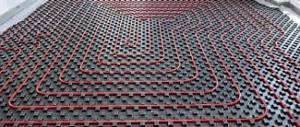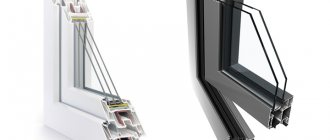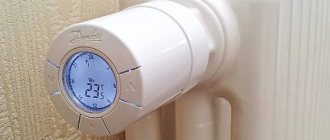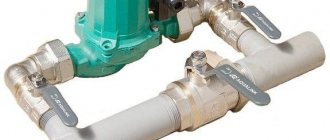Choosing batteries for heating in your own home is not at all the same as buying batteries for use in an apartment where the central heating system always operates. Heating a private home involves organizing your own heating system, which, as a rule, is based on a gas boiler. This and other nuances impose certain requirements on radiators.
To help you navigate the issue, Santekhbomb has prepared an article with recommendations. After reading it, you will learn which heating batteries are best for a private home, what you should pay attention to when choosing them, and also get an idea of the main characteristics of the currently most popular batteries suitable for working in gas heating systems.
Features of a gas heating system
First of all, it is worth identifying several features inherent in gas heating systems.
- Low operating pressure.
- Absence of pressure surges and water hammer due to the closed circuit.
- The ability to use good quality coolant, change its type or properties.
Based on this, such common types of heating batteries as cast iron and bimetallic should be immediately “swept away” from the selection. Yes, they are wonderful in their own way, but there is no point in using them in a closed system. Bimetallic ones, despite all their advantages, cost a lot - more expensive than aluminum and often even cast iron analogues, which will make their purchase completely impractical. Cast iron ones are simply not suitable for autonomous gas heating. It's all about their high thermal inertia - because of it, you won't heat up the room quickly, and the efficiency of cast iron is such that using it in your home will be too expensive. This will also prevent the automatic temperature control system, if any, from working. In this case, the main advantages of cast iron disappear - there will be no water hammer in such a system, as already mentioned, and ensuring good quality of the coolant will not be difficult.
If you are looking for heating batteries, which ones are best for a private home, the only options left are aluminum batteries. But you should choose them based on your needs. To do this, let’s take a closer look at how exactly they interact with a gas heating system, what their main advantages are, and what characteristics you should pay attention to before purchasing.
Bimetallic batteries
The name bimetal means the combination of two or more metals in one product. The interior of the batteries is made of steel or copper material, which increases their safety and ensures reliable operation. The outer side is equipped with aluminum ribs. These devices can be called the evolutionary pinnacle in the development of radiators. Manufacturers claim that such devices can last 40 years.
Bimetallic heating radiators Sira
Despite their high cost, bimetallic radiators have been occupying a leading position in the heating appliance market in recent years. It is advisable to purchase such batteries if the issue of price is not a top priority for you. Then they will fully cover the financial costs and will serve for many years.
Manufacturers are constantly improving their devices. Which bimetallic heating batteries should I choose for my home? Among the well-known manufacturers, it is worth highlighting the following companies: Polywarm, Sira, Teplopribor. The German Kermi is deservedly recognized as one of the leaders in this industry.
Bimetallic heating radiators Teplopribor
As can be seen from the description, you can place both types of batteries in your own homes. Recently, they have gained wide popularity among consumers due to their high heating performance. Now let’s compare them according to technical indicators to find out which heating radiators are best suited for a private home.
Heat volume
The aluminum battery section produces 200 watts of energy. Part of the generated power is converted, and the rest of the heat is released through radiation. These batteries can warm up a room within 10 minutes, which has a positive effect on savings.
Heat transfer on bimetallic radiators is based on a different principle: the steel core somewhat slows down its production. Each model distributes heat differently, but they all take longer to warm up a room than aluminum units. There are no significant differences in other characteristics.
Radiator heat transfer table.
Aluminum batteries support temperatures up to 110°C, while bimetallic batteries operate at 130°C.
Installation
Both varieties have steel fasteners that are mounted on screws or plastic dowels. Due to their light weight, installation of these devices is easy. Installation and maintenance are carried out using shaped tools and a set of keys.
Life time
Bimetallic radiators are made from two metals and, accordingly, are more durable. They can work efficiently for 15-20 years, while aluminum ones, on average, function for about 10 years. If the operating time of the heating device is important to you, then it is better to give preference to the first option.
In the domestic heating system, the water contains a large number of chemical components. All these impurities have a destructive effect on aluminum, which reacts with them. As a result, rust forms on the walls, which over time can damage the device. For stable operation, the pH value should be no more than 8 units.
Bimetallic devices use a special coating that protects it from chemical impurities, making the material less susceptible to rust. However, in some cases, hydrogen may enter the liquid, which will lead to rapid rotting of the components.
When answering the question about which heating radiator is best for a private home, you should think about purchasing a model of this particular type first. Bimetallic batteries are currently perhaps the most popular type of such equipment. The design of radiators of this type includes elements made of two types of metal - aluminum and steel (or copper). Hence their name. The advantages of bimetallic radiators, among other things, include:
- ability to withstand very high coolant pressure (up to 35 atm) and water hammer;
- attractive appearance;
- light weight;
- durability (can last up to 25 years).
In general, bimetallic heating radiators are best suited for a private home. Reviews of models of this type available on the Internet clearly indicate this. Country property owners consider such equipment to be of very high quality, easy to install and operate. In appearance, such radiators resemble aluminum ones, but at the same time they are much more reliable.
Based on the above, it can be noted that both subtypes are suitable for use in private homes. Now let’s conduct a comparative analysis of a number of features and find out which of them should be preferred.
We invite you to familiarize yourself with Exhaust fans in a private home
Heat volume
An aluminum heating radiator (its section) provides 200 W of energy. One part is released in the form of radiation, and the second is converted. Within 10 minutes after switching on, the air in the room begins to warm up, which provides an opportunity to save a lot of money.
In bimetallic heat transfer occurs differently: the steel core slightly slows down its spread. In principle, this indicator may differ depending on the model. Otherwise there are no significant differences.
Features of aluminum batteries
Aluminum radiators are the best batteries for gas heating in a private home. The thing is that their small shortcomings are completely unimportant when used in an autonomous heating system. Not the highest resistance to corrosion determines increased requirements for the quality of the coolant, but when you heat your home yourself using a gas boiler, there can be no problems with the coolant, because it requires a very small volume of water. Pressure drops and water hammer, which are undesirable for aluminum, will also not occur in autonomous heating, so all the disadvantages simply disappear.
But they have many advantages. First of all, this is an affordable price - in terms of price and quality ratio for a private home, they will be an ideal option. Next is low inertia. They heat up very quickly, so you will spend a minimum of gas to start the system, and the volume of coolant required for this is small. They look great too. In addition, the light weight of aluminum makes them easy to ship and install.
However, when choosing batteries, pay attention to their heat dissipation. You should carefully calculate the number of sections - it is generally accepted that heating 1 square meter requires 100 W of thermal energy. To be more confident, it is recommended to add another 10-15% to this figure. If the total heat transfer from the radiators in the room is insufficient to heat it, you risk getting a temperature difference between the floor and ceiling. The floor simply will not have time to warm up, and light heated air will rush upward. This is due to the low thermal inertia of aluminum.
To avoid electrochemical corrosion, it is best to connect aluminum radiators to a gas boiler using plastic pipes. It is recommended to slow down the radiators themselves. Also, do not forget about the release of hydrogen gas by aluminum, which is formed during the reaction of this metal with water, which is saturated with oxygen - and install a gas exhaust system together with a Mayevsky tap.
Characteristics of heating radiators for an apartment
Life time
Heating radiators are designed for a fairly long service life, reaching several decades. And neither the beauty of the form nor the price of the batteries can in any way affect their long-term service. Therefore, the possibility of sudden damage to the battery and the unpleasant moment of flooding of neighbors should be minimized.
Radiator efficiency
The type of material that has the best thermal conductivity is responsible for this. The batteries you choose should get the job done no matter how cold the weather outside is. Their task is to provide the apartment with the optimal temperature and its owners with comfortable living.
Radiator resistance to pressure
Each heating system has its own operating pressure, and purchased batteries must be designed for it. This criterion is important in apartment buildings (especially high-rise buildings) with central heating, since cases of water hammer occurring as a result of a sharp increase in pressure in the system are possible.
Coolant requirements
As a rule, the coolant is water, but its quality is transferred by metals differently. As it travels a long way through the heating system, it transports microparticles that are undesirable for some metals and can cause a harmful chemical reaction.
Price of heating radiators
It’s good when you manage to find a combination of price and quality for yourself. This is especially important in the modern world, which forces us to save. And why overpay, if inexpensive batteries that successfully do their job are quite suitable.
The mentioned criteria are the main ones when choosing heating radiators. Still, it’s worth remembering that perfect equipment does not exist. This means that there are no batteries that would simultaneously include all of the above points in their characteristics. Consequently, there will always be something to give up, choosing the most important from everything.
Model overview
What exactly do manufacturers offer today? One of the most affordable models is the Garda 500. Its cast body can withstand pressure up to 27 bar, with a heat output of 175 W per section. It is adapted for use in harsh Russian conditions and has a 5-year warranty.
Among the slightly more expensive options, we note the Alecord 500 radiator. Its maximum pressure is lower, 24 bar, but this is more than enough. The thermal output here is greater, 186 W per section. And the manufacturer’s warranty is for 15 years. Alecord 500 has an original design and is coated with a special protective paint.
Halsen 350 is a model in the mid-price segment, made in Russia. The maximum pressure is still the same, 24 bar, with an operating pressure of 16. 1 section produces 140 W of heat with a very small volume of 0.26 liters. The manufacturer's warranty here is even longer - 20 years. The radiator is made by injection molding; additional reliability is provided by pressure testing performed at the factory.
Those wishing to purchase the most stylish radiator can be recommended to pay attention to the Royal Thermo DreamLiner 500. The weight of one section is decent - 1.37 kg, heat output 175 W, with a volume of 0.37 liters. Made in Russia according to Italian standards, it has an aerodynamic design and slightly rounded shapes. A distinctive feature is the additional fins present on the vertical collector, which increases heat transfer by 5% (POWERSHIFT technology).
In general, it can be noted that domestically produced models are cheaper than those made in Europe. However, there is no direct relationship between price and quality - when choosing, we recommend first of all paying attention to the characteristics and warranty period from the manufacturer. As for the quality of any model, including the most inexpensive ones, you can be sure that all products at Santekhbomb meet Russian standards, as evidenced by certificates.











